History
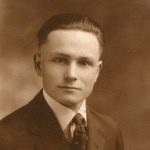
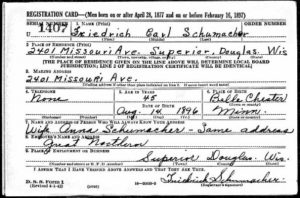 As I have researched my family history, I have come across a number of World War II draft registration cards for older men. I found that to be very strange. It seemed odd to me that men who were technically too old to serve in battle…at least by military standards, were required to register, and quite possibly be drafted into the war. Some of these men weren’t so very old by today’s standards, such as my great uncle, Friedrich Schumacher, who was 45 at the time of his World War II draft registration, or my grandfather, George Byer, who was 48 at the time of his World War II draft registration, but others, such as my grandfather, Allen Luther Spencer, who was 63 at the time of his World War II registration, were much older. These draft registrations really surprised me. Why would our government need to have these men register?
As I have researched my family history, I have come across a number of World War II draft registration cards for older men. I found that to be very strange. It seemed odd to me that men who were technically too old to serve in battle…at least by military standards, were required to register, and quite possibly be drafted into the war. Some of these men weren’t so very old by today’s standards, such as my great uncle, Friedrich Schumacher, who was 45 at the time of his World War II draft registration, or my grandfather, George Byer, who was 48 at the time of his World War II draft registration, but others, such as my grandfather, Allen Luther Spencer, who was 63 at the time of his World War II registration, were much older. These draft registrations really surprised me. Why would our government need to have these men register?
My curious mind had to know the answer to that question, and so I began to look online to see if anything was said about it at all. Well, it only took looking at three websites to find the answer. I wondered if they were just desperate for soldiers, because as most people know, World War II saw the most American war deaths at 405,399, than any other war in American history. Nevertheless, that was not the reason for the Fourth 
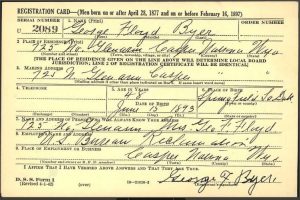 Registration, which became known as the Old Man’s Draft, because it targeted men between the ages of 45-64 years of age. No, these men were not going to be soldiers who were require to go into battle. This draft registration was intended to provide the government with a register of manpower…men who might be eligible for national service. Help was needed on the home front, and this was a way to ensure that the manpower needed was available. After all, if you are drafted, you are required to serve.
Registration, which became known as the Old Man’s Draft, because it targeted men between the ages of 45-64 years of age. No, these men were not going to be soldiers who were require to go into battle. This draft registration was intended to provide the government with a register of manpower…men who might be eligible for national service. Help was needed on the home front, and this was a way to ensure that the manpower needed was available. After all, if you are drafted, you are required to serve.
Registration of the Old Man’s Draft began on April 27, 1942 at local draft boards around the country, and like the patriotic citizens they were, my great uncle, and my grandfathers, along with many, many other older men, went to register. The lines were long when the men went in to register, according to the Poughkeepsie Journal, but the biggest regret that was heard among the men waiting there was…that they were too old to fight!! Seriously!! There were no complaints about standing for hours in line, or complaints about having to register at all…just that they would not see battle. These were not warmongers, but rather patriots who wanted to help in whatever way they could, and now Uncle Sam was telling them that their contribution was important. It felt 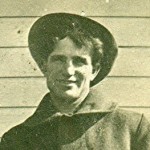
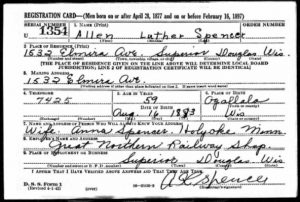 amazing to these men. They were needed!! The biggest complication was that some of the men couldn’t read or write, and some had forgotten things like addresses, telephone numbers, or dates (including the year of birth, which is evident on my grandfather’s card in that his year of birth was listed as 1883, but he was born in 1879). Nevertheless, these men were hopeful that somehow they could be useful in the war effort. I find that completely amazing…especially in light of the lack of patriotism so often seen these days.
amazing to these men. They were needed!! The biggest complication was that some of the men couldn’t read or write, and some had forgotten things like addresses, telephone numbers, or dates (including the year of birth, which is evident on my grandfather’s card in that his year of birth was listed as 1883, but he was born in 1879). Nevertheless, these men were hopeful that somehow they could be useful in the war effort. I find that completely amazing…especially in light of the lack of patriotism so often seen these days.

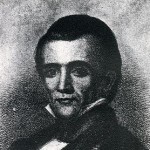 Before Bob and I were even married, I knew that he was related to one of our presidents…namely James Knox Polk. Since then, I have found that we are actually related to several presidents, but James K Polk remains the one with whom the link seems the most obvious. Still, while I knew of the relationship, there were things about him that I didn’t know. One of the most notable being his connection to the Smithsonian Institution. In 1829, one James Smithson died in Italy, and while most people would not think that would have impacted the United States of America, it actually did. So, who was Smithson anyway. Smithson had been a fellow of the venerable Royal Society of London from the age of 22, publishing numerous scientific papers on mineral composition, geology, and chemistry. In 1802, he overturned popular scientific opinion by proving that zinc carbonates were true carbonate minerals, and one type of zinc carbonate was later named Smithsonite in his honor.
Before Bob and I were even married, I knew that he was related to one of our presidents…namely James Knox Polk. Since then, I have found that we are actually related to several presidents, but James K Polk remains the one with whom the link seems the most obvious. Still, while I knew of the relationship, there were things about him that I didn’t know. One of the most notable being his connection to the Smithsonian Institution. In 1829, one James Smithson died in Italy, and while most people would not think that would have impacted the United States of America, it actually did. So, who was Smithson anyway. Smithson had been a fellow of the venerable Royal Society of London from the age of 22, publishing numerous scientific papers on mineral composition, geology, and chemistry. In 1802, he overturned popular scientific opinion by proving that zinc carbonates were true carbonate minerals, and one type of zinc carbonate was later named Smithsonite in his honor.
James Smithson’s will had one odd footnote to it, that in the end, would change everything. Smithson didn’t have much family, in fact, he had just one nephew at the time of his passing. His entire estate was willed to that nephew, with one condition attached to it. If his nephew should die without children, the entire estate was to go to “the United States of America, to found at Washington, under the name of the Smithsonian Institution, an Establishment for the increase and diffusion of knowledge.” Smithson’s curious bequest to a country that he had never visited garnered significant attention on both sides of the Atlantic Ocean. James Smithson was a scientist, who wasn’t well known, but he apparently had a dream for the United States…a country that somehow held his interest. Six years after his death, his nephew, Henry James Hungerford, indeed died without children, and on July 1, 1836, the United States Congress authorized acceptance of Smithson’s gift. President Andrew Jackson sent diplomat Richard Rush to England to negotiate for transfer of the funds, and two years later Rush set sail for home with 11 boxes containing a total of 104,960 gold sovereigns, 8 shillings, and 7 pence, as well as Smithson’s mineral collection, library, scientific notes, and personal effects. After the gold was melted down, it amounted to a fortune worth well over $500,000.
The money was sent to the United States with Smithson’s instructions for its use. It might have seemed like a simple request at the time of the will’s writing, but in the end, the money would sit in the bank waiting for a decade. The reason…a debate on how to use the money. Apparently, even though instructions for the money’s use were given, they did leave a few of the details up to the United States government. Finally, on this day August 10, 1846 James K Polk signed the Smithsonian Institution Act into law. After considering a series of recommendations, including the creation of a national university, a public library, or an astronomical observatory, Congress agreed that the bequest would support the creation of a museum, a library, and a program of research, publication, and collection in the sciences, arts, and history.
Today, the Smithsonian is composed of 19 museums and galleries including the recently announced National Museum of African American History and Culture, nine research facilities throughout the United States and the world, and the national zoo. Besides the original Smithsonian Institution Building, popularly known as the  Castle, visitors to Washington DC, tour the National Museum of Natural History, which houses the natural science collections, the National Zoological Park, and the National Portrait Gallery. The National Museum of American History houses the original Star-Spangled Banner and other artifacts of United States history. The National Air and Space Museum has the distinction of being the most visited museum in the world, exhibiting such marvels of aviation and space history as the Wright brothers’ plane and Freedom 7, the space capsule that took the first American into space. John Smithson, the Smithsonian Institution’s great benefactor, is interred in a tomb in the Smithsonian Building. It has been a pretty amazing use of that money. I think James Smithson would be pleased.
Castle, visitors to Washington DC, tour the National Museum of Natural History, which houses the natural science collections, the National Zoological Park, and the National Portrait Gallery. The National Museum of American History houses the original Star-Spangled Banner and other artifacts of United States history. The National Air and Space Museum has the distinction of being the most visited museum in the world, exhibiting such marvels of aviation and space history as the Wright brothers’ plane and Freedom 7, the space capsule that took the first American into space. John Smithson, the Smithsonian Institution’s great benefactor, is interred in a tomb in the Smithsonian Building. It has been a pretty amazing use of that money. I think James Smithson would be pleased.
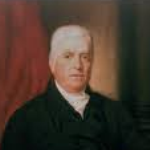
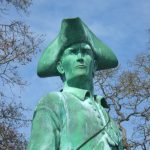 Years ago, when my sister, Caryl Reed lived in the Seattle, Washington area, I remember thinking how strange the names of some of the places were. Now that my daughter, Amy Royce and her family live in northern Washington, the names of those places have come to my attention again. It’s not that the names are all so very odd, but rather that I have a curiosity about how things and places got their names. Places like Whidbey Island, and Puget Sound are just not your typical Indian names like so much of the area, such as Snoqualmie Pass, Issaquah, or Puyallup, which all have Indian meanings. So, how did these other places get their names. Well yesterday, part of the mystery was solved for me. I’m sure some people know what I found out, but surprisingly it may not be as many people from Washington state as you might think.
Years ago, when my sister, Caryl Reed lived in the Seattle, Washington area, I remember thinking how strange the names of some of the places were. Now that my daughter, Amy Royce and her family live in northern Washington, the names of those places have come to my attention again. It’s not that the names are all so very odd, but rather that I have a curiosity about how things and places got their names. Places like Whidbey Island, and Puget Sound are just not your typical Indian names like so much of the area, such as Snoqualmie Pass, Issaquah, or Puyallup, which all have Indian meanings. So, how did these other places get their names. Well yesterday, part of the mystery was solved for me. I’m sure some people know what I found out, but surprisingly it may not be as many people from Washington state as you might think.
The islands of the coast of Washington, which extend for a number of miles inland, have always been of great interest to explorers. Waterways with islands must always lead to passages, right? Well, maybe not. There was an explorer named Joseph Whidbey who led an expedition that embarked on August 8, 1794 to look for a Northwest Passage near Juneau, Alaska. Whidbey’s goal was to locate the passage known today as the Inside Passage to Juneau. He found the passage, but felt that since it was inaccessible most of the year, due to ice in the area, it would not really serve any useful purpose. Of course, as anyone who has cruised to Alaska knows, that passage has become a very useful waterway, especially in the tourism business. Whidbey had also accompanied Lieutenant Peter Puget in small boats in 1792, to explore what is now known as the Puget Sound. On June 2nd of that trip, the men discovered Deception Pass, which was so named because the explorers erroneously thought that Whidbey Island was a peninsula, until the pass proved otherwise. The excursion was part of the Vancouver Expedition, headed up by Captain George Vancouver, who also named Whidbey Island in Joseph Whidbey’s honor.
The Northwest passage did exist, but it would not be Joseph Whidbey, Peter Puget, or George Vancouver who 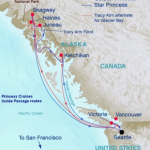
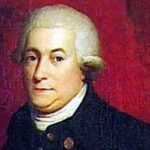 would find it, and it would be a number of years before it was discovered at all. In the end, one Robert McClure discovered the passage in 1850, and Norwegian explorer Roald Amundsen who would first navigate it with a small expedition in 1903 to 1906. The passage was unusable until about 2009 when Artic ice which had prevented regular marine shipping throughout most of the year melted some, moving back to open more waterways for the shipping industry. For me, this was interesting information, because my curious mind wonders about these things like just where did that name come from.
would find it, and it would be a number of years before it was discovered at all. In the end, one Robert McClure discovered the passage in 1850, and Norwegian explorer Roald Amundsen who would first navigate it with a small expedition in 1903 to 1906. The passage was unusable until about 2009 when Artic ice which had prevented regular marine shipping throughout most of the year melted some, moving back to open more waterways for the shipping industry. For me, this was interesting information, because my curious mind wonders about these things like just where did that name come from.
 Imagine a world without income taxes. I’m sure a lot of us would love to do just that. I don’t know what the taxes are called in other nations, but suffice it to say that the name doesn’t mean a thing…it’s still a tax, and it still has to be paid. In the United States…for many years, there was no income tax, at least not until August 5, 1861, when President Lincoln imposes the first federal income tax to help pay for the Civil War costs. The tax started when President Lincoln and Congress agreed to impose a tax of 3% on annual incomes over $800.00. I’m sure that the people were as unhappy about that as we would be today about gun control. The whole thing seemed unfair and for many unconstitutional.
Imagine a world without income taxes. I’m sure a lot of us would love to do just that. I don’t know what the taxes are called in other nations, but suffice it to say that the name doesn’t mean a thing…it’s still a tax, and it still has to be paid. In the United States…for many years, there was no income tax, at least not until August 5, 1861, when President Lincoln imposes the first federal income tax to help pay for the Civil War costs. The tax started when President Lincoln and Congress agreed to impose a tax of 3% on annual incomes over $800.00. I’m sure that the people were as unhappy about that as we would be today about gun control. The whole thing seemed unfair and for many unconstitutional.
The constitutionality of a federal income tax, was something President Lincoln checked into thoroughly, and I’m sure that it was the last thing he wanted to do, because that kind of thing can be  political suicide, and in this case…I have to wonder if it played a part in Lincoln’s assassination, although it was said that John Wilkes Booth killed him because he disagreed with his stance on slavery.
political suicide, and in this case…I have to wonder if it played a part in Lincoln’s assassination, although it was said that John Wilkes Booth killed him because he disagreed with his stance on slavery.
Sometime, around March of 1861, Lincoln began to look at the government’s ability to wage a war against the South, and found that it was lacking. He sent letters to cabinet members Edward Bates, Gideon Welles, and Salmon Chase. Lincoln wanted to get their opinions as to whether or not the president had the constitutional authority to “collect [such] duties.” According to the documents, and their interpretations, which are now housed in the Library of Congress…Lincoln was very concerned about maintaining federal authority over collecting revenue from ports along the southeastern seaboard…as they might fall under the control of the Confederacy.

The Revenue Act was broadly written to define income as gain “derived from any kind of property, or from any professional trade, employment, or vocation carried on in the United States or elsewhere or from any source whatever.” The comparable minimum tax as of 2003 would have put the minimum taxable income at about $16,000. The Income Tax went into effect, and the Civil War was funded. Then in 1871, Congress repealed Lincoln’s tax law, but in 1909, they passed the 16th Amendment, which made Income Tax a permanent tax, and the one we use today. The 16th Amendment was ratified in 1913. Sometimes, I wish they hadn’t done that, but I suppose it is necessary, though maybe not always fair.
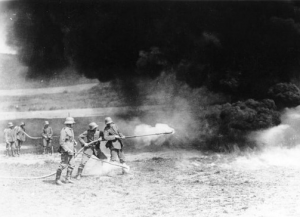 Over the centuries of life on Earth, there have been numerous wars, and numerous weapons of warfare. Yet, few could bring fear to the heart of an infantryman quicker than the Flammenwerfer. Developed by the Germans during World War I, the Flammenwerfer…or Flamethrower, in English…once lit could throw a steady stream of flames 20 to 30 feet in front of it. For the men on the ground, this meant one of two things. They could run…abandoning the relative safety of their foxhole, usually with the result of being shot down by the enemy, or they could stand their ground and be incinerated. It wasn’t much of a choice really, and most ran in the hope of escaping the machine gun fire that would undoubtedly follow the flamethrower. It was a situation of instant death…no matter which choice a soldier made…not to mention the fact that every fiber of a soldier’s being and training told them to stand their ground. This weapon took much of it toll on the soldier’s sense of bravery.
Over the centuries of life on Earth, there have been numerous wars, and numerous weapons of warfare. Yet, few could bring fear to the heart of an infantryman quicker than the Flammenwerfer. Developed by the Germans during World War I, the Flammenwerfer…or Flamethrower, in English…once lit could throw a steady stream of flames 20 to 30 feet in front of it. For the men on the ground, this meant one of two things. They could run…abandoning the relative safety of their foxhole, usually with the result of being shot down by the enemy, or they could stand their ground and be incinerated. It wasn’t much of a choice really, and most ran in the hope of escaping the machine gun fire that would undoubtedly follow the flamethrower. It was a situation of instant death…no matter which choice a soldier made…not to mention the fact that every fiber of a soldier’s being and training told them to stand their ground. This weapon took much of it toll on the soldier’s sense of bravery.
The Flammenwerfer was developed in 1915 by the Germans, and first used in battle against the Allied forces on this day, July 30, 1915 at the Battle of Hooge. Eleven days before that battle, British infantry had captured the German occupied village of Hooge, located near Ypres in Belgium, by detonating a large mine. Using the flamethrowers, along with machine guns, trench mortars and hand grenades, the Germans got their positions 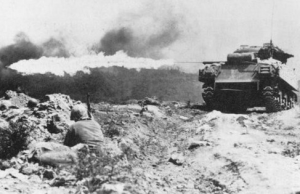 back on July 30, 1915. They broke through enemy front lines with ease, pushing the British forces back to their second trench. Only a few men were lost to actual burns, but a British officer was heard to explain that the weapons had a great demoralizing effect, and when added to the assault of the other powerful weapons, they proved mercilessly efficient at Hooge. I suppose that is true. I can think of few things more demoralizing for a soldier than running from your position in fear. Soldiers don’t take kindly to fear…or running away.
back on July 30, 1915. They broke through enemy front lines with ease, pushing the British forces back to their second trench. Only a few men were lost to actual burns, but a British officer was heard to explain that the weapons had a great demoralizing effect, and when added to the assault of the other powerful weapons, they proved mercilessly efficient at Hooge. I suppose that is true. I can think of few things more demoralizing for a soldier than running from your position in fear. Soldiers don’t take kindly to fear…or running away.
During World War I, the Germans were the only ones to use such a weapon, and not because it was difficult to make. So, why didn’t the Allies us it too? It was one of the great puzzles that emerged from World War I. Why? The British made three attempts with larger, more unwieldy prototypes: the smallest one was equal in size to the German Grof, which the enemy had almost abandoned by 1916. The French were more persistent, and by 1918 had at least seven companies trained in using flamethrowers, and still the use of the weapon never progressed to the same level as that of the German army.
By World War II, however, the flamethrower was the most dramatic hand weapon used by any Army and the most effective for its purpose. But it was during the 20th century that engineers and scientists placed flames 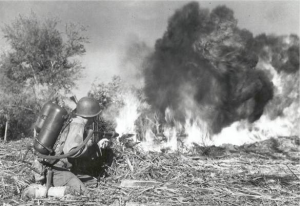 under advanced technological control in an effort to make flamethrowers portable, reliable and reasonably safe…for the user anyway. Prior to that the words “friendly fire” had a second meaning in that flamethrowers could kill the operator while he was doing his best to kill the enemy with it. The result of this new technology was a device with as much psychological impact as it’s lethality impact. That was the chief reason why the United States, Great Britain and other world powers used the flamethrower from World War I through the Vietnam War. Even today, Russia still has flamethrowers in its inventory. I guess it is an important weapon, but for most of us, I think that just the thought of using it on someone would make us seriously ill.
under advanced technological control in an effort to make flamethrowers portable, reliable and reasonably safe…for the user anyway. Prior to that the words “friendly fire” had a second meaning in that flamethrowers could kill the operator while he was doing his best to kill the enemy with it. The result of this new technology was a device with as much psychological impact as it’s lethality impact. That was the chief reason why the United States, Great Britain and other world powers used the flamethrower from World War I through the Vietnam War. Even today, Russia still has flamethrowers in its inventory. I guess it is an important weapon, but for most of us, I think that just the thought of using it on someone would make us seriously ill.

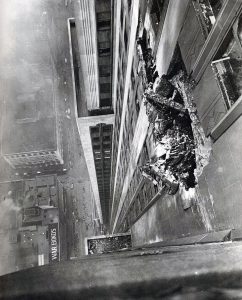 World War II saw the shooting down of more of our military planes that most of us want to think about. We saw the loss by planes being shot down, but also transport planes lost, and planes lost in training accidents. The loss was felt deeply. I realize that accidents are a fact of life and during wartime they are probably more likely to happen than other times, but some accidents just have a bigger impact on our emotions than others. Such was the case of the accident of July 28, 1945.
World War II saw the shooting down of more of our military planes that most of us want to think about. We saw the loss by planes being shot down, but also transport planes lost, and planes lost in training accidents. The loss was felt deeply. I realize that accidents are a fact of life and during wartime they are probably more likely to happen than other times, but some accidents just have a bigger impact on our emotions than others. Such was the case of the accident of July 28, 1945.
That morning, the skies over New York City were filled with heavy fog. A B-52 Mitchell Bomber with two pilots and one passenger aboard, en route from New Bedford, Massachusetts, to LaGuardia Airport in New York City, was diverted because the fog was so thick. As it came into the metropolitan area on that Saturday morning, air-traffic controllers instructed the plane to fly to Newark Airport instead.
The new flight plan took the plane over Manhattan. The pilots were warned that the Empire State Building, the tallest building in the city at that time, was not visible. In an effort to gain better visibility, the pilot of the bomber was flying relatively slowly and quite low. As the plane came in straight at the Chrysler Building in midtown, it swerved to avoid the collision, thereby setting it in a collision path with the Empire State Building, hitting the building near the 79th floor. The fuel tanks exploded, filling the building with flames down to the 75th floor, and out of the building at the impact site. One engine from the plane went straight through the building and landed in a penthouse apartment across the street. Other plane parts were embedded in and on top of nearby buildings. The other engine snapped an elevator cable while at least one woman was riding in the elevator car. The emergency auto brake saved the woman from crashing to the bottom, but the engine fell down the shaft and landed on top of it. Thankfully, the rescuers pulled the woman from the elevator, thereby saving her life.
July 28th was a Saturday that year, so there were fewer people in the building. The loss of life in the Empire State Building was only 11 people, but death came by way of horrific burns from the jet fuel, or being thrown from the building. The 11 people killed were all workers from the War Relief Services Department of the National Catholic Welfare Conference…the office that the plane crashed into on that fateful day. The other three deaths were the two pilots and their passenger. The crash left an 18 by 20 foot hole in the side of the Empire State Building. The building itself, stood however, because, this plane was nowhere near the size of the planes 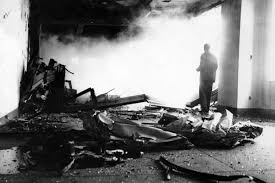
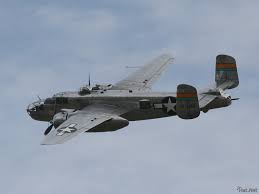 that took down the World Trade Center in Manhattan on Sept 11, 2001, an event that probably seemed eerily similar to those who were alive and living in New York City on July 28, 1945. The crash caused one million dollars in damage at that time, which would equate to about 10.5 million these days. For many people this was an event, much like 9-11 that would never be forgotten, even though it was not a terrorist attack, but rather a tragic accident.
that took down the World Trade Center in Manhattan on Sept 11, 2001, an event that probably seemed eerily similar to those who were alive and living in New York City on July 28, 1945. The crash caused one million dollars in damage at that time, which would equate to about 10.5 million these days. For many people this was an event, much like 9-11 that would never be forgotten, even though it was not a terrorist attack, but rather a tragic accident.
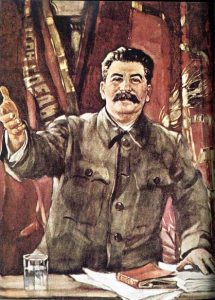 Imagine being in a country where being afraid is a crime. I’m sure you are wondering how that is possible…in any country, but I assure you, it is. That was the case on this day, July 27, 1943 in Russia. Joseph Stalin was the premier and dictator of Russia at that time in history, and Adolf Hitler was the dictator of Germany. The Germans were advancing into Russian territory, and Stalin was determined to stop them, no matter the cost.
Imagine being in a country where being afraid is a crime. I’m sure you are wondering how that is possible…in any country, but I assure you, it is. That was the case on this day, July 27, 1943 in Russia. Joseph Stalin was the premier and dictator of Russia at that time in history, and Adolf Hitler was the dictator of Germany. The Germans were advancing into Russian territory, and Stalin was determined to stop them, no matter the cost.
Hitler had become quite bold because of the early successes against Russia in his goal of taking Leningrad and Stalingrad. The attack on Stalingrad proved, however, that the Russians had superior manpower and it was an enormous drain on German resources and troop strength. The Germans were repulsed by a fierce Soviet fighting force, that had been reinforced with more men and materials. Hitler made the decision to turn his sights to Leningrad.
Stalin needed to make sure his force wouldn’t back down…no matter what happened. The motivation to stand 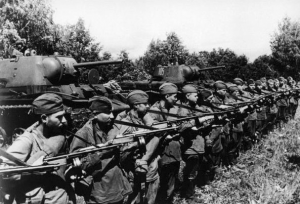 their ground needed to apply to both officers and civilians alike, or he was sure that Leningrad would be lost. That was when Stalin decided to put order number 227 into effect. So, what was order number 227? The order declared, “Panic makers and cowards must be liquidated on the spot. Not one step backward without orders from higher headquarters! Commanders…who abandon a position without an order from higher headquarters are traitors to the Fatherland.” Basically the order said that no one…not one person would be a coward. The order became known as the “not one step backward” order. The military personnel, as well as civilians were forced to fight for their city.
their ground needed to apply to both officers and civilians alike, or he was sure that Leningrad would be lost. That was when Stalin decided to put order number 227 into effect. So, what was order number 227? The order declared, “Panic makers and cowards must be liquidated on the spot. Not one step backward without orders from higher headquarters! Commanders…who abandon a position without an order from higher headquarters are traitors to the Fatherland.” Basically the order said that no one…not one person would be a coward. The order became known as the “not one step backward” order. The military personnel, as well as civilians were forced to fight for their city.
I think I can understand what Stalin was doing, but it seems such a drastic measure to take. Still, while some  people might fight the enemy to the end, others might decide that their city wasn’t worth their life. If the penalty for backing off was instant liquidation, then standing and fighting became the only way to have a chance at life. In my opinion, that as far as ways to gain loyalty goes, this was not the best of plans, but then forced loyalty seldom is. Still, one must never underestimate the love a patriot feels for their country. The “not one step backward” order was virtually unnecessary, in that on the day the order was issued, the Russian peasants and other supporters in the Leningrad region killed a German official, Adolf Beck, whose job was to send agricultural products from occupied Russia to Germany and to German troops. The Russian patriots also set fire to the granaries and barns in which the stash of agricultural products was stored before transport. A partisan pamphlet issued an order of its own: “Russians! Destroy the German landowners. Drive the Germans from the land of the Soviets!” I guess Stalin had misjudged his peoples’ loyalty.
people might fight the enemy to the end, others might decide that their city wasn’t worth their life. If the penalty for backing off was instant liquidation, then standing and fighting became the only way to have a chance at life. In my opinion, that as far as ways to gain loyalty goes, this was not the best of plans, but then forced loyalty seldom is. Still, one must never underestimate the love a patriot feels for their country. The “not one step backward” order was virtually unnecessary, in that on the day the order was issued, the Russian peasants and other supporters in the Leningrad region killed a German official, Adolf Beck, whose job was to send agricultural products from occupied Russia to Germany and to German troops. The Russian patriots also set fire to the granaries and barns in which the stash of agricultural products was stored before transport. A partisan pamphlet issued an order of its own: “Russians! Destroy the German landowners. Drive the Germans from the land of the Soviets!” I guess Stalin had misjudged his peoples’ loyalty.
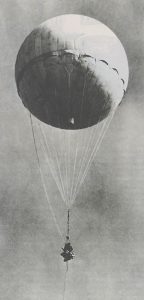 I suppose a true World War II history buff might know about some of the strange war stories there are out there, and I rather thought I was becoming a World War II history buff, but I had never heard of the Japanese Balloon Bombs. I can’t imagine how a nation could send a random bomb over another nation, not knowing where it will land, or who it will kill…but then, the evil we have seen in the 21st century has proven to be very much the same. I guess there really is nothing new under the sun. Where evil exists, horrible things happen. Such was the case with the Japanese Balloon Bombs. The Japanese were an evil nation at that time, and they didn’t care who they hurt. in 1945, a Japanese Balloon Bomb landed in rural Oregon, ad killed six people . As it turns out, these were the only World War II combat casualties within the continental 48 states. Apparently, the accuracy of the balloon bombs left something to be desired…thankfully.
I suppose a true World War II history buff might know about some of the strange war stories there are out there, and I rather thought I was becoming a World War II history buff, but I had never heard of the Japanese Balloon Bombs. I can’t imagine how a nation could send a random bomb over another nation, not knowing where it will land, or who it will kill…but then, the evil we have seen in the 21st century has proven to be very much the same. I guess there really is nothing new under the sun. Where evil exists, horrible things happen. Such was the case with the Japanese Balloon Bombs. The Japanese were an evil nation at that time, and they didn’t care who they hurt. in 1945, a Japanese Balloon Bomb landed in rural Oregon, ad killed six people . As it turns out, these were the only World War II combat casualties within the continental 48 states. Apparently, the accuracy of the balloon bombs left something to be desired…thankfully.
The idea of a balloon bomb was to send in a bomb that was silent. The problem is that balloons are hard to control. They go with the flow of the wind currents, so you don’t know where they will land. Then again, the Japanese were at war with the world, so they really didn’t care where the balloons would land. The six people who were killed by the Fu-Go or fire-balloon bomb, as they were called, were a Sunday School teacher Elyse Mitchell (and her unborn child), her 13 and 14 year old students, Jay Gifford, Edward Engen, Sherman Shoemaker, Dick Patzke, all of whom were killed instantly, when the bomb exploded. Dick Patzke’s sister, Joan was severely burned, and died moments later. The group had stopped for a moment, because Elyse Mitchell was feeling ill, and while her husband, Reverend Archie Mitchell talked with construction workers in the area, the six victims went to investigate a balloon they saw. It would prove to be a fatal mistake. The group had been going on a Saturday afternoon picnic near Klamath Falls, Oregon. They had only walked about 100 yards from the car. One of the road-crew workers, Richard Barnhouse, said “There was a terrible explosion. Twigs flew through the air, pine needles began to fall, dead branches and dust, and dead logs went up.”
Made of rubberized silk or paper, each balloon was about 33 feet in diameter. Barometer-operated valves released hydrogen if the balloon gained too much altitude or dropped sandbags if it flew too low. The balloons were filled with 19,000 cubic feet of hydrogen and the jet stream drew them eastward. They were designed to travel across the Pacific to North America, where they would drop incendiary devices or anti-personnel explosives. I would think the hydrogen alone would make a horrible bomb, but attached to the  balloon was the actual bomb. The Japanese released an estimated 9,000 fire balloons during the last months of World War II. At least 342 reached the United States, with some drifting as far as Nebraska. Some were shot down. Some caused minor damage when they landed, but no injuries. One hit a power line and blacked out the nuclear-weapons plant at Hanford, Washington. But the only known casualties from the 9,000 balloons…and the only combat deaths from any cause on the U S mainland were the five kids and their Sunday school teacher going to a picnic. What a valiant victory for the Japanese that was.
balloon was the actual bomb. The Japanese released an estimated 9,000 fire balloons during the last months of World War II. At least 342 reached the United States, with some drifting as far as Nebraska. Some were shot down. Some caused minor damage when they landed, but no injuries. One hit a power line and blacked out the nuclear-weapons plant at Hanford, Washington. But the only known casualties from the 9,000 balloons…and the only combat deaths from any cause on the U S mainland were the five kids and their Sunday school teacher going to a picnic. What a valiant victory for the Japanese that was.
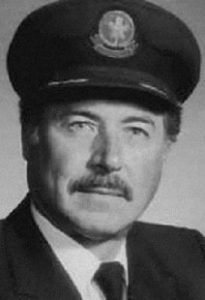
 Plane crashes are always tragic events. The loss of life and property is devastating. Sometimes, however, a pilot and his crew are able to pull off a landing in unbelievable circumstances. Something like that leaves everyone from the passengers, families, the NTSB, and the world scratching their heads in disbelief. Years ago I watched a movie about just such a flight. The flight was Air Canada Flight 143. A couple of days ago, I saw that it was the 33rd anniversary of that flight which occurred on July 23, 1983, and I thought about what a miracle that whole situation was. Canada Air had just made the conversion from pounds of fuel to kilograms of fuel. Unfortunately, as is often the case in these types of conversions, things were not converting as smoothly as the airline had hoped. On 22 July 1983, Air Canada’s Boeing 767, registered as C-GAUN, c/n 22520/47, from Toronto to Edmonton where it underwent routine checks. The next day, it was flown to Montreal. Following a crew change, it departed Montreal as Flight 143 for the return trip to Edmonton via Ottawa, with Captain Robert (Bob) Pearson and First Officer Maurice Quintal at the controls. The crew had been somewhat leery of taking off with the fuel indicator taped off as inoperable. It would seem logical to most of us that Air Canada should have waited until all systems were operable before using the plane, but that was not the case.
Plane crashes are always tragic events. The loss of life and property is devastating. Sometimes, however, a pilot and his crew are able to pull off a landing in unbelievable circumstances. Something like that leaves everyone from the passengers, families, the NTSB, and the world scratching their heads in disbelief. Years ago I watched a movie about just such a flight. The flight was Air Canada Flight 143. A couple of days ago, I saw that it was the 33rd anniversary of that flight which occurred on July 23, 1983, and I thought about what a miracle that whole situation was. Canada Air had just made the conversion from pounds of fuel to kilograms of fuel. Unfortunately, as is often the case in these types of conversions, things were not converting as smoothly as the airline had hoped. On 22 July 1983, Air Canada’s Boeing 767, registered as C-GAUN, c/n 22520/47, from Toronto to Edmonton where it underwent routine checks. The next day, it was flown to Montreal. Following a crew change, it departed Montreal as Flight 143 for the return trip to Edmonton via Ottawa, with Captain Robert (Bob) Pearson and First Officer Maurice Quintal at the controls. The crew had been somewhat leery of taking off with the fuel indicator taped off as inoperable. It would seem logical to most of us that Air Canada should have waited until all systems were operable before using the plane, but that was not the case.
The flight seemed to be going smoothly, but about half way between Montreal and Edmonton, at an altitude on 41,000 feet, the aircraft’s cockpit warning system sounded, indicating a fuel pressure problem on the aircraft’s left side. Assuming a fuel pump had failed, the pilots turned it off, since gravity should feed fuel to the aircraft’s two engines. In most situations, that would have worked, but when the plane was fueled, the technician failed to accurately convert the fuel from pounds to kilograms, and the plane had run out of fuel. Running out of fuel  in a small plane, flying at much lower altitudes has been known to get people killed, but this was a Boeing 767, and it was at an altitude of 41,000 feet. This had all the makings of a disaster…but somehow, that was not what happened. In this case, the event would prove to be the finest hour for the pilot and crew.
in a small plane, flying at much lower altitudes has been known to get people killed, but this was a Boeing 767, and it was at an altitude of 41,000 feet. This had all the makings of a disaster…but somehow, that was not what happened. In this case, the event would prove to be the finest hour for the pilot and crew.
The passengers on this plane had the unusual advantage of having at the controls, a pilot who was an experienced glider pilot. Now, as you know gliders have no fuel in them. You are pulled into the air by another plane and then released to glide in for a landing. That’s an easy enough task for a trained glider pilot in a glider plane, but this was a modern day, wide body jet. The idea of gliding this plane in for a safe landing was…well, unheard of. Robert “Bob” Pearson was that pilot, and with the help of his crew and an air traffic controller, he safely glided the plane into an abandoned Royal Canadian Air Force airstrip that was being used as a drag strip…at the very moment of the landing of the plane. The men could not see that, however, until they were almost on top of the people. Thankfully, the people on the runway saw the plane and got out of the way.
The crew had hoped to make Winnipeg, but with the best glide speed and the rate of descent, there was no way. Then, Quintal remembered Gimli, and the abandoned strip became their last hope. They were too high for it, so Pearson performed a slip, which is a glide maneuver to increase drag, causing the plane to lose altitude quickly. To add to the problem, the nose gear came down, but did not lock as the rest of the gear had. Could things have been more dire? In the end, Captain Pearson executed the landing perfectly, in spite of all of the problems, and the fact that the Winnipeg Sports Car Club was on the field with everything needed to assist in 
 this emergency, the plane landed without a single death in the plane or on the ground, and the fuel starvation scenario became part of the pilots training in their simulators. The first pilots to try the program in the simulator all crashed, and believed that it was an impossible scenario, until they were told that it had happened, and that the pilot landed safely. The flight has since been dubbed the Gimli Glider. And, that’s a miracle for the books.
this emergency, the plane landed without a single death in the plane or on the ground, and the fuel starvation scenario became part of the pilots training in their simulators. The first pilots to try the program in the simulator all crashed, and believed that it was an impossible scenario, until they were told that it had happened, and that the pilot landed safely. The flight has since been dubbed the Gimli Glider. And, that’s a miracle for the books.
 If I tell you that there exists in this world, a children’s railway, would you think of the Orphan Train, bringing children out West for adoption into families there? Or would you think of some kind of forced child labor on the railways? Either way…you would be wrong. The Children’s Railway was started in Soviet Russia in 1932. The concept is a unique one. The idea was to teach teenaged children to build and run a railroad as a way of learning the railroad trade. It was an extracurricular activity that was voluntary. Things like that aren’t offered in this country…at least not that I’m aware of. Nevertheless, I think my grandfather, Allen Luther Spencer might have enjoyed that, had it been offered in his time. I also think that my cousin by marriage, James Forseen, might have loved that since he has always loved trains, and managed to land a job with the railroad. He loved them so much that he had to have one in the wedding photos when he
If I tell you that there exists in this world, a children’s railway, would you think of the Orphan Train, bringing children out West for adoption into families there? Or would you think of some kind of forced child labor on the railways? Either way…you would be wrong. The Children’s Railway was started in Soviet Russia in 1932. The concept is a unique one. The idea was to teach teenaged children to build and run a railroad as a way of learning the railroad trade. It was an extracurricular activity that was voluntary. Things like that aren’t offered in this country…at least not that I’m aware of. Nevertheless, I think my grandfather, Allen Luther Spencer might have enjoyed that, had it been offered in his time. I also think that my cousin by marriage, James Forseen, might have loved that since he has always loved trains, and managed to land a job with the railroad. He loved them so much that he had to have one in the wedding photos when he  married my cousin Dani Byer Forseen. Just imagine James, if you could have worked on a railroad in high school!!
married my cousin Dani Byer Forseen. Just imagine James, if you could have worked on a railroad in high school!!
As I said, the children’s railway was a phenomenon that originated in the USSR. The first Children’s Railway opened in Gorky Park in Moscow, on July 24, 1932. It was a greatly developed activity in Soviet times. By the time the USSR broke up, there were 52 children’s railways in existence in that country. Many children’s railways are still functioning in post-Soviet states and in Eastern Europe, so obviously this is an activity that has taken off…and imagine the kids who would stay out of trouble if they fell in love with railroad work. I can envision the kids having such a great time running the railroad that they would never have the time or the inclination to get into trouble or into gangs. Their imagination would be too busy.
The children’s railway has come so far that many of them exhibit railway technology not seen anymore on the  main lines and they can be seen as heritage railways. Even though a few exceptions exist, most of the children’s railways that were built in the communist block have a track gauge of at least 600 mm (1 feet 11 5/8 inches) and can carry full size narrow gauge rolling stock. Of course, for the sake of safety and training purposes, the children’s railways are all run under the supervision of adult railroad workers, but what better way for things to be done. The children’s railways in existence these days are mostly for the purpose of tourism, but I suppose that if necessary, they could be used for other reasons. Whatever their purpose is today, I think the Children’s Railways sound like a very cool idea.
main lines and they can be seen as heritage railways. Even though a few exceptions exist, most of the children’s railways that were built in the communist block have a track gauge of at least 600 mm (1 feet 11 5/8 inches) and can carry full size narrow gauge rolling stock. Of course, for the sake of safety and training purposes, the children’s railways are all run under the supervision of adult railroad workers, but what better way for things to be done. The children’s railways in existence these days are mostly for the purpose of tourism, but I suppose that if necessary, they could be used for other reasons. Whatever their purpose is today, I think the Children’s Railways sound like a very cool idea.

